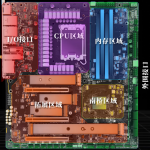目录
本文概览:主要介绍了如下部分,(1)介绍了数据库连接池和Druid功能。(2)Druid相关操作,如下:
- 连接池初始化
- 从连接池获取Connection
- 通过connection执行sql
- 关闭connection
1 数据连接池介绍
1.1 数据库连接池引入
1、背景
通过JDBC直接访问数据库,使用这种方式,每一次执行sql,都需要创建新的连接,执行sql完成之后,还需要关闭连接。如下:
当使用JDBC创建数据库连接时候,需要耗费很大的资源。如果在程序中,每次需要访问数据库时候,都进行数据库连接,那么势必会造成性能低下;同时,如果用户失误忘记释放数据库连接,会导致资源的浪费等。而数据库连接池就是解决该问题,通过管理连接池中的多个连接对象(connection),实现connection重复利用。从而,大大提高了数据库连接方面的性能。
2、连接池现状
目前存在多个开源的java数据库连接池,如DBCP、C3P0、Druid等,这些连接池都是基于JDK的线程池接口来实现,接口如下
|
1 2 3 4 5 6 7 |
public interface ConnectionPoolDataSource extends CommonDataSource { // 常用 PooledConnection getPooledConnection() throws SQLException; PooledConnection getPooledConnection(String user, String password) throws SQLException; } |
连接池中常涉及到两个参数有:
- 最小连接数:初始化时,创建该数目的connection放入连接池中。
- 最大连接数:允许创建connection的最大数值。当系统请求连接时候,且连接池中不存在空闲的连接,如果connection总数未超过最大连接数,那么连接池负责创建新的connection对象,并返回该对象;如果connection总数已经到达该最大连接数,那么连接池将用户请求转入等待队列。
1.2 Druid连接池介绍
Druid首先实现了一个数据库连接池的功能,这个功能和其他连接池没有什么差异,都是维护一个连接集合,包括数据库连接的创建、关闭等。但是Druid相比其他连接池,提供了监控功能,就通过filter-chain来实现各个filter的操作,实现对sql的监控,这正是Druid的价值所在。
Druid除了提供了一个数据库连接池功能。还具有如下功能:
(1)可以监控数据库访问性能,Druid内置提供了一个功能强大的StatFilter插件,能够详细统计SQL的执行性能,这对于线上分析数据库访问性能有帮助。
(2)数据库密码加密。直接把数据库密码写在配置文件中,这是不好的行为,容易导致安全问题。DruidDruiver和DruidDataSource都支持PasswordCallback。
(3)SQL执行日志,Druid提供了不同的LogFilter,能够支持Common-Logging、Log4j和JdkLog,你可以按需要选择相应的LogFilter,监控你应用的数据库访问情况。
(4)自定义过滤器。扩展JDBC,如果你要对JDBC层有编程的需求,可以通过Druid提供的Filter机制,很方便编写JDBC层的扩展插件。
1.3 Druid与ConnectionPoolDataSource比较
实现了jvax.sql.ConnectionPoolDataSource的接口中第一个函数接口,对于第二个函数不进行支持
|
1 2 3 4 5 6 7 8 9 10 |
@Override public PooledConnection getPooledConnection() throws SQLException { return getConnection(maxWait); } // 德鲁伊不支持这个带参数接口函数的实现 @Override public PooledConnection getPooledConnection(String user, String password) throws SQLException { throw new UnsupportedOperationException("Not supported by DruidDataSource"); } |
2 连接池存储结构
连接池中的连接存储:Conetions和activeConnections两个数组。
|
1 2 3 4 5 |
// 存放的是:从连接池获取连接时,从这个数组中获取 private volatile DruidConnectionHolder[] connections; // 存放的是:正在使用的连接connection protected final Map<DruidPooledConnection, Object> activeConnections |
有以下说明:
- 连接池中保存的元素是什么?是DruidConnectionHolder(保存了JDK的connection对象)。
- 连接池中每一个连接,用完之后必须调用close()。在close中通过recyCle()把连接从activeConections集合中重新移动到connections[],达到重复利用连接的目的。
1、关于DruidDataSource的activeConnections
- 在activeConections中添加连接,是在DruidDataSource#getConnection时进行获取的。
- 删除activeConnections中连接,在关闭连接DruidPooledConneciton#close中使用DruidDataSource#recycle,如下:
|
1 2 3 |
protected void recycle(DruidPooledConnection pooledConnection) throws SQLException { ... } |
所以,使用DruidDataSouce连接池获取数据库连接时,在使用完这个connection之后,如果没有进行close操作,那么activeConnections就不会删除,只会增加。此时因为线程池中动态创建连接的线程CreateConnectionThread中判断一个条件就是
|
1 |
if (activeCount + poolingCount >= maxActive) {...} |
此时一个场景就是poolingCount=0,但是activeCount的线程数目是已经达到了maxAcive,那么此时线程池就会发现无法再提供连接的故障。
为了解决这个问题,所以在init函数中启动了一个DestroyConnectionThread线程来完成这件事情。但是需要用户设置一个removeAbandoned变量才可以生效。
2、connections
(1) connections添加 一个连接
- 在init()初始化时进行增加;
- 在createAndStartCreatorThread中进行增加
(2)connections删除一个连接
在getConnectionInternal中获取连接时,进行删除。通过这个函数获取的连接已经被关闭,那么此时在调用这个函数的getConnectionDirect中会进行判断这个获取连接是否关闭,如果关闭,再次通过getConnectionInternal进行获取,如下代码:
|
1 2 3 4 5 6 7 8 9 10 11 12 13 14 15 16 17 18 19 20 21 22 23 24 25 |
public DruidPooledConnection getConnectionDirect(long maxWaitMillis) throws SQLException { for (;;) { DruidPooledConnection poolalbeConnection = getConnectionInternal(maxWaitMillis); if (isTestOnBorrow()) { // 1.进行校验,失败则删除相应的activeConections中连接 boolean validate = testConnectionInternal(poolalbeConnection.getConnection()); if (!validate) { if (LOG.isDebugEnabled()) { LOG.debug("skip not validate connection."); } Connection realConnection = poolalbeConnection.getConnection(); discardConnection(realConnection); continue; } } else { Connection realConnection = poolalbeConnection.getConnection(); //2.进行校验,失败则删除相应的activeConections中连接 if (realConnection.isClosed()) { discardConnection(null); // 传入null,避免重复关闭 continue; ...... } } |
3 连接池初始化
通过init函数进行初始化连接池。这个函数在getConection()时进行调用。在执行init函数时,首先会初始化存放连接的数组conections,然后启动两个线程
(1)CreateConnectionThread,动态在connections中添加连接
(2)DestroyConnectionThread,动态删除actiConnections中很久不用的连接。
3.1 通过init来初始化
1、通过init函数完成初始化
|
1 2 3 4 5 6 7 8 9 10 11 12 13 14 15 16 17 |
public void init() throws SQLException { // 1. 初始化连接 for (int i = 0, size = getInitialSize(); i < size; ++i) { Connection conn = createPhysicalConnection(); DruidConnectionHolder holder = new DruidConnectionHolder(this, conn); connections[poolingCount++] = holder; } ........ // 2.记录线程持仓统计信息的线程 createAndLogThread(); // 3. 启动CreateConnectionThread,动态在connections中添加连 createAndStartCreatorThread(); // 4. 启动 DestroyConnectionThread,动态删除actiConnections中很久不用的连接。 createAndStartDestroyThread(); } |
2、初始化时机
(1)方式1:在配置文件中
|
1 2 3 |
<bean id="dataSource" class="com.alibaba.druid.pool.DruidDataSource" init-method="init" destroy-method="close"> ... </bean> |
(2)方式2:通过第一次执行getConnection
|
1 2 3 4 5 6 7 8 9 10 11 |
public DruidPooledConnection getConnection(long maxWaitMillis) throws SQLException { //在init中 执行初始化.如果此时已经初始化了连接池,那么此时就直接返回。 init(); if (filters.size() > 0) { FilterChainImpl filterChain = new FilterChainImpl(this); return filterChain.dataSource_connect(this, maxWaitMillis); } else { return getConnectionDirect(maxWaitMillis); } } |
3.2 动态创建连接CreateConnectionThread
该线程负责动态的创建连接,维护连接数在initSize到maxActive之间。如下代码说明了在连接池动态创建一个连接的时机:
|
1 2 3 4 5 6 7 8 9 10 11 12 13 14 15 16 17 18 19 20 21 22 23 24 25 26 27 28 29 30 31 32 33 |
public class CreateConnectionThread extends Thread { public void run() { try { // 1.必须存在线程等待,才创建连接 // notEcmptyWaitThreadCount值为: // 执行takeLast()或者pollLast(long nanos)操作,发现 poolingCount = 0时等待的线程的个数。 if (poolingCount >= notEmptyWaitThreadCount) { empty.await(); // 进行阻塞 } // 2. 防止创建超过maxActive数量的连接 // activeCount是正在运行的使用连接个数; // poolingCount是线程池中连接个数,初始化时该值为initialSize,最大为maxActive; if (activeCount + poolingCount >= maxActive) { empty.await(); // 进行阻塞 continue; } Connection connection = null; try { // 3.通过JDBC创建一个连接 connection = createPhysicalConnection(); } catch (SQLException e) { .... } // 4.放入到connections[]数组中。并且增加pollingCount的值 put(connection); } } |
3.3 动态删除连接DestroyConnectionThread
该线程的作用就是:关闭 连接池connnections[]空闲连接 和 连接池activeConections[]中超时运行连接 。
1、创建并启动线程代码如下:
|
1 2 3 4 5 6 7 8 9 10 11 12 13 14 15 16 17 18 19 |
protected void createAndStartDestroyThread() { destoryTask = new DestroyTask(); // 需要自己配置 if (destroyScheduler != null) { long period = timeBetweenEvictionRunsMillis; if (period <= 0) { period = 1000; } destroySchedulerFuture = destroyScheduler.scheduleAtFixedRate(destoryTask, period, period, TimeUnit.MILLISECONDS); initedLatch.countDown(); return; } // 默认情况下,通过DestroyTask来完成。 String threadName = "Druid-ConnectionPool-Destroy-" + System.identityHashCode(this); destroyConnectionThread = new DestroyConnectionThread(threadName); destroyConnectionThread.start(); } |
2、通过DetroyTask来实现,包括两部分:
- 关闭 连接池connnections[]中 空闲时间超过一个阈值的连接
- 关闭 连接池activeConneection[] 运行超过一个阈值的连接
|
1 2 3 4 5 6 7 8 9 10 11 12 13 14 15 |
public class DestroyTask implements Runnable { @Override public void run() { // 1.关闭 连接池connnections[]中 空闲时间超过一个阈值的连接 shrink(true); // 2.removeAbandoned属性值为ture时 if (isRemoveAbandoned()) { // 在activeConnections中查找运行时间超过removeAbandonedTimeoutMillis的连接,然后通过JDBC的close方法进行关闭 removeAbandoned(); } } } |
(1)shrink(true)
用于关闭connecitons[]中空闲连接数,涉及到属性有:
- minIdle:最小空闲连接数
- minEvictableIdleTimeMillis 空闲时间的阈值,超过改阈值需要进行关闭该空闲连接
|
1 2 3 4 5 6 7 8 9 10 11 12 13 14 15 16 17 18 19 20 21 22 23 24 25 26 27 28 |
public void shrink(boolean checkTime) { ..... try { final int checkCount = poolingCount - minIdle; final long currentTimeMillis = System.currentTimeMillis(); // 1.连接数是否大于最小空闲连接数,如果大于,则需要处理多余的空闲congtion,否则不进行处理 for (int i = 0; i < checkCount; ++i) { DruidConnectionHolder connection = connections[i]; if (checkTime) { // 2.选取空闲时间大于minEvictableIdleTimeMillis的connection long idleMillis = currentTimeMillis - connection.getLastActiveTimeMillis(); if (idleMillis >= minEvictableIdleTimeMillis) { evictList.add(connection); } else { break; } } else { evictList.add(connection); } } ..... // 3.通过JDBC关闭多余空闲connnection for (DruidConnectionHolder item : evictList) { Connection connection = item.getConnection(); JdbcUtils.close(connection); destroyCount.incrementAndGet(); } } |
(2)removeAbandoned()
处理activeConenctions[]中运行超时连接,涉及到属性有:
- removeAbandoned。是否需要处理activeConections超时连接:true表示处理;false表示不处理。
- removeAbandonedTimeoutMillis。运行超时的阈值
|
1 2 3 4 5 6 7 8 9 10 11 12 13 14 15 16 17 |
public int removeAbandoned() { Iterator<DruidPooledConnection> iter = activeConnections.keySet().iterator(); for (; iter.hasNext();) { // 1.获取运行超时的connection long timeMillis = (currrentNanos - pooledConnection.getConnectedTimeNano()) / (1000 * 1000); if (timeMillis >= removeAbandonedTimeoutMillis) { .... abandonedList.add(pooledConnection); } } for (DruidPooledConnection pooledConnection : abandonedList) { // 2.通过JDBC关闭该连接 JdbcUtils.close(pooledConnection); } } |
4 从连接池获取Connection
通过两种方式可以获取连接
- 直接获取
- 通过filter-chain获取
|
1 2 3 4 5 6 7 8 9 10 11 12 13 14 15 16 17 18 |
@Override public DruidPooledConnection getConnection() throws SQLException { // 默认会设置一个最大连接时间,这个最大设置时间需要在配置DruidDataSource时进行配置。 return getConnection(maxWait); } public DruidPooledConnection getConnection(long maxWaitMillis) throws SQLException { init(); // 1.情况1 包含过滤器,则通过filter-chain模式来产生新的连接 if (filters.size() > 0) { FilterChainImpl filterChain = new FilterChainImpl(this); return filterChain.dataSource_connect(this, maxWaitMillis); } else { // 2.情况2 不包含过滤器 return getConnectionDirect(maxWaitMillis); } } |
4.1 情况1 使用filter-chain模式来产生新的连接
查看FilterChainImpl#dataSource_connect实现代码
|
1 2 3 4 5 6 7 8 9 10 11 |
@Override public DruidPooledConnection dataSource_connect(DruidDataSource dataSource, long maxWaitMillis) throws SQLException { // 1. 通过一个pos来表示执行到filters[pos]的过滤器,直到执行完filters的所有过滤器,才执行下一步 if (this.pos < filterSize) { DruidPooledConnection conn = nextFilter().dataSource_getConnection(this, dataSource, maxWaitMillis); return conn; } // 2. 通过情况2中getConnectionDirect来从连接池获取一个连接。 return dataSource.getConnectionDirect(maxWaitMillis); } |
这里使用filter的目的,就在于在filter可以做一些操作,如下两个例子
- 以LogFilter#dataSource_getConnection为例
|
1 2 3 4 5 6 7 8 9 10 11 12 13 14 15 |
public DruidPooledConnection dataSource_getConnection(FilterChain chain, DruidDataSource dataSource, long maxWaitMillis) throws SQLException { //1. 继续执行filterchain#dataSource_connect,来执行下一个filter#dataSource_getConnection(每一个过滤都需要一个这步操作) DruidPooledConnection conn = chain.dataSource_connect(dataSource, maxWaitMillis); //2. 这个过滤器需要完成的操作 ConnectionProxy connection = (ConnectionProxy) conn.getConnectionHolder().getConnection(); if (connectionConnectAfterLogEnable && isConnectionLogEnabled()) { connectionLog("{conn-" + connection.getId() + "} pool-connect"); } // 3.返回conn return conn; } |
- 以StatFilter#dataSource_getConnection为例
|
1 2 3 4 5 6 7 8 9 10 11 12 13 14 15 |
@Override public DruidPooledConnection dataSource_getConnection(FilterChain chain, DruidDataSource dataSource, long maxWaitMillis) throws SQLException { //1. 继续执行filterchain#dataSource_connect,来执行下一个filter#dataSource_getConnection(每一个过滤都需要一个这步操作) DruidPooledConnection conn = chain.dataSource_connect(dataSource, maxWaitMillis); //2. 这个过滤器需要完成的操作 if (conn != null) { conn.setConnectedTimeNano(); StatFilterContext.getInstance().pool_connection_open(); } // 3.返回conn return conn; } |
由上,filter操作模板就是包括3步:
|
1 2 3 4 5 6 7 8 9 10 11 |
DruidPooledConnection dataSource_connect(DruidDataSource dataSource, long maxWaitMillis) throws SQLException{ //1. 继续执行filterchain#dataSource_connect,来执行下一个filter#dataSource_getConnection(每一个过滤都需要一个这步操作) DruidPooledConnection conn = chain.dataSource_connect(dataSource, maxWaitMillis); //2. 这个过滤器需要完成的操作 ....... ....... // 3.返回conn return conn; } |
所以,假设DruidDataSources中filters包括三个filter:filter1,filter2,filter3,每一个dataSource_getConnection代码模板为:
|
1 2 3 4 5 6 7 8 9 10 11 |
{ //1. 继续执行filterchain#dataSource_connect,来执行下一个filter#dataSource_getConnection(每一个过滤都需要一个这步操作) DruidPooledConnection conn = chain.dataSource_connect(dataSource, maxWaitMillis); //2. 这个过滤器需要完成的操作 System.out.pringln(执行当前类名字:xxx.class) ....... // 3.返回conn return conn; } |
则在DruidDataSource执行getConnection()之后,此时打印结果就是:(类似于递归,先走到底,然后再返回依次执行)
|
1 2 3 |
执行当前类名字:filter3 执行当前类名字:filter2 执行当前类名字:filter1 |
4.2 情况2 直接获取getConnectionDirect()
在getConnectionDirect中获取流程
|
1 2 3 4 5 6 7 8 9 10 11 12 13 14 15 16 17 18 19 20 21 22 23 24 25 26 27 28 29 30 |
public DruidPooledConnection getConnectionDirect(long maxWaitMillis) throws SQLException { for (;;) { // 1. 从connections[]获取连接,并从connections[]中删除这个连接,然后在activeConnections中增加这个连接 DruidPooledConnection poolalbeConnection = getConnectionInternal(maxWaitMillis); // 2.判断连接是否可以使用,如果不可用:执行discardConnection将这个连接从connection执行connetion.close。然后继续执行continue,通过getConnectionInternal来获取连接。 // 2.1 测试connetions是否有效可用 if (isTestOnBorrow()) { // 通过执行sql校验connnection是否有效 boolean validate = testConnectionInternal(poolableConnection.getConnection()); } else { // 2.2 测试是否close Connection realConnection = poolalbeConnection.getConnection(); // 2.3 对超过一个空闲时间阈值的连接,进行测试该连接是否有效可用。 if (isTestWhileIdle()) { long timeBetweenEvictionRunsMillis = this.getTimeBetweenEvictionRunsMillis(); if (timeBetweenEvictionRunsMillis <= 0) { timeBetweenEvictionRunsMillis = DEFAULT_TIME_BETWEEN_EVICTION_RUNS_MILLIS; } // 超过一个空闲等待时间的连接,进行测试conneciton是否有效可用 if (idleMillis >= timeBetweenEvictionRunsMillis) { boolean validate = testConnectionInternal(poolableConnection.getConnection()) } } // 3.如果可以,则执行返回获取的连接 } |
1、getConnectionInternal(maxWaitMillis);
在DruidDataSource中的如下代码:
|
1 2 3 4 5 6 7 8 9 10 11 12 13 14 15 16 |
private DruidPooledConnection getConnectionInternal(long maxWait) throws SQLException { .... // 加锁。获取一个连接池元素时,需要添加锁,然后从connections[]数组中获取连接, loock.lock(); ... // 如果设置了最大等待时间maxWait,就 if (maxWait > 0) { holder = pollLast(nanos); } else { holder = takeLast(); } .... // 解锁 lock.unlock ... } |
(1)lock
这也可以解释为什么在获取连接时,需要增加超时时间,因为lock是阻塞的。 在获取连接时,如果设置了超时,则获取连接时间如果超时则会抛出异常(参考pollLast(nanos)中的代码)
(2) pollLast(nanos)
|
1 2 3 4 5 6 7 8 9 10 |
private DruidConnectionHolder pollLast(long nanos) throws InterruptedException, SQLException { // 连接池connections[]没有可用连接时,阻塞等待最大等待时间 estimate = notEmpty.awaitNanos(estimate); ... // 获取连接 decrementPoolingCount(); DruidConnectionHolder last = connections[poolingCount]; connections[poolingCount] = null; } |
(3)takeLast
|
1 2 3 4 5 6 7 8 9 10 11 |
DruidConnectionHolder takeLast() throws InterruptedException, SQLException { // 连接池connections[]没有可用连接时,一直会阻塞等待 notEmpty.await(); ... // 获取连接 decrementPoolingCount(); DruidConnectionHolder last = connections[poolingCount]; connections[poolingCount] = null; } |
2、testConnectionInternal(poolableConnection.getConnection())
通过使用获取的conneciton执行一个测试sql来校验是否生效。
|
1 2 3 4 5 6 7 8 9 10 11 12 13 14 15 16 17 18 19 20 21 22 |
protected boolean testConnectionInternal(Connection conn) { .... Statement stmt = null; ResultSet rset = null; try { stmt = conn.createStatement(); if (getValidationQueryTimeout() > 0) { // 1.设置执行sql超时时间 stmt.setQueryTimeout(validationQueryTimeout); } // 2.执行测试sql rset = stmt.executeQuery(validationQuery); if (!rset.next()) { return false; } } finally { JdbcUtils.close(rset); JdbcUtils.close(stmt); } return true } |
3、isTestOnBorrow()和isTestWhileIdle()比较
二者只能有一个为true,如果都为true,优先选择isTestOnBorrow()。
(1)共同点
都是校验connection可用
(2)区别
isTestWhileIdle()只针对空闲时间超过一定时间的连接。而testConnectionInternal是针对所有连接
4、涉及到属性有:
- maxWait,获取连接时的最大等待时间
- testOnBorrow,是否校验connection有效可用。
- validationQuery,在testOnBorrow为true情况下,获取连接后,通过执行该sql校验connection是否正常
- validationQueryTimeout,在testOnBorrow为ture情况下,执行validationQeury时,超时时间,默认不进行超时设置
- testWhileIdle,超过一个空闲等待时间的连接,进行测试conneciton是否有效可用。在testOnBorrow为false情况下使用。
- timeBetweenEvictionRunsMillis,空闲等待时间,testWhileIdle=true的时候使用
5 通过Connection执行Sql工作机制
druid最大价值就在于提供监控功能。通过filter-chain来实现各个filter的操作(如自定义了一个FilterEventAdapter,那么就可以实现对执行sql的监控)。
使用filter执行sql的流程:
(1)第一步 初始化连接池
(2)第二步 获取DruidPooledPreparedStatement,这个类中的statement的值有两种情况。
(3)第三步 执行PreparedStatementProxyImpl
5.1 介绍
在“从连接池获取连接”小节 中实现ConnectionPoolDataSource#getPooledConnection()查询连接时,使用filter-chain模式来产生新的连接,类似于递归。filter-chain除了上述获取连接,还有查询、更新等数据库操作。以执行查询为例,查看failterChainimpl的statement_executeQuery操作为例,如下代码:
|
1 2 3 4 5 6 7 8 9 10 11 12 13 |
public ResultSetProxy statement_executeQuery(StatementProxy statement, String sql) throws SQLException { if (this.pos < filterSize) { return nextFilter().statement_executeQuery(this, statement, sql); } ResultSet resultSet = statement.getRawObject().executeQuery(sql); if (resultSet == null) { return null; } return wrap(statement, resultSet); } |
5.2 实现原理
通过druid连接池得到DruidPooledConnection,通过这个连接获取到DruidPooledStatement.
1、初始化连接
在初始化连接池时,需要创建连接,分为如下两种情况:
- 如果filters不为空,则在连接池中中DruidConnectionHolder包含的connectio的类型就是ConnectionProxyImpl。
- 如果filters为空,则在连接池中DruidConnectionHolder包含的connectio的类型就是Connection。
|
1 2 3 4 5 6 7 8 9 10 11 12 |
public Connection createPhysicalConnection(String url, Properties info) throws SQLException { Connection conn; if (getProxyFilters().size() == 0) { conn = getDriver().connect(url, info); } else { conn = new FilterChainImpl(this).connection_connect(info); } createCount.incrementAndGet(); return conn; } |
2、获取DruidPooledPreparedStatement
(1)从初始化连接池中获取连接DruidPooledConnection,
(2)通过DruidPooledConnection来获取DruidPooledPreparedStatement。这里分为两种情况:
- 包含过滤器(即DruidDataSource中filters不为空)
- 不包含过滤器(即DruidDataSource中filters为空)
查看DruidPooledConnection#prepareStatement操作
|
1 2 3 4 5 6 7 8 9 10 11 12 13 14 15 16 17 18 19 20 21 22 |
public PreparedStatement prepareStatement(String sql) throws SQLException { ........ ........ if (stmtHolder == null) { try { // 1.这里分根据conn的类型分为两种情况: //(1)如果conn是Connection类型,则此时就是preparedStatement类型 //(2)如果conn是ConnectionProxyImpl,此时就是PreparedStatementProxyImpl stmtHolder = new PreparedStatementHolder(key, conn.prepareStatement(sql)); holder.getDataSource().incrementPreparedStatementCount(); } catch (SQLException ex) { handleException(ex); } } // 2.DruidPooledPrepardStatement就是封装了一个stament,这个statement由stmtholder得到,对于statement类型有两种,如第一步。 DruidPooledPreparedStatement rtnVal = new DruidPooledPreparedStatement(this, stmtHolder); holder.addTrace(rtnVal); return rtnVal; } |
3、执行PreparedStatementProxyImpl实现监控功能
如果包含过滤器就通过PreparedStatementProxyImpl来执行sql,查看执行函数
|
1 2 3 4 5 6 |
public boolean execute() throws SQLException { ...... // 通过filterChain来执行 firstResultSet = createChain().preparedStatement_execute(this); return firstResultSet; } |
4、 如何确认是否包含过虑器?
就是看DruidDataSource中filters是否为空,即看用户在配置DruidDataSource时,是否配置了filters。
6 关闭连接
通过关闭连接实现回收连接,达到可重复利用connection的目的。在执行close操作时也分为:使用过滤器和不使用过滤器两种,如下代码
|
1 2 3 4 5 6 7 8 9 10 11 12 |
public void close() throws SQLException { ..... List<Filter> filters = dataSource.getProxyFilters(); // 1.使用过滤器 if (filters.size() > 0) { FilterChainImpl filterChain = new FilterChainImpl(dataSource); filterChain.dataSource_recycle(this); } else { // 2.直接回收,不使用过滤器 recycle(); } } |
在执行DruidPooledConnections#close,执行如下recycle,分为是否回收连接两种情况:
|
1 2 3 4 5 6 7 8 9 10 11 12 13 14 15 16 17 18 19 20 21 22 23 24 |
public void recycle() throws SQLException { if (this.disable) { return; } DruidConnectionHolder holder = this.holder; if (holder == null) { if (dupCloseLogEnable) { LOG.error("dup close"); } return; } // 1.情况1 abandoned为false,表示还没有通过JDBC关闭该连接,此时可以进行回收连接,重复利用 if (!this.abandoned) { DruidAbstractDataSource dataSource = holder.getDataSource(); dataSource.recycle(this); } // 2.情况2 abandoned为true,表示已经通过JDBC关闭了该连接,此时不进行回收线程 this.holder = null; conn = null; transactionInfo = null; closed = true; } |
1、设置DruidPooledConnections的abandoned属性为true的时机
在DestroyConnectionThread线程执行DestroyTask时,在通过removeAbandoned()关闭超时运行连接时,设置了abndoned属性为true:
|
1 2 3 4 5 6 7 8 9 10 11 12 |
public class DestroyTask implements Runnable { @Override public void run() { shrink(true); if (isRemoveAbandoned()) { // 通过JDBC关闭超时连接,并设置连接的abandoned属性为true removeAbandoned(); } } } |
removeAbandoned()执行逻辑如下,通过JDBC关闭超时连接,并设置连接的abandoned属性为true
|
1 2 3 4 5 6 7 8 9 10 11 12 13 14 15 |
public int removeAbandoned() { .... for (DruidPooledConnection pooledConnection : abandonedList) { synchronized (pooledConnection) { if (pooledConnection.isDisable()) { continue; } } JdbcUtils.close(pooledConnection); // 设置连接的abandoned属性为true pooledConnection.abandond(); } .... } |
2、dataSource.recycle(this)
作用:将conneciton重新放到connections[]中。
|
1 2 3 4 5 6 7 8 9 10 11 12 13 14 15 16 17 |
/** * 回收连接,重新把连接放回connections[]中 */ protected void recycle(DruidPooledConnection pooledConnection) throws SQLException { .... final Connection physicalConnection = holder.getConnection(); .... // 1、校验回收的连接是否可以有效使用 if (testOnReturn) { boolean validate = testConnectionInternal(physicalConnection); ... } // 2、将连接重新放到connecitons[]中 putLast(holder, lastActiveTimeMillis); } |
3、涉及到相关属性有
- testOnReturn 是否需要对回收的连接,检查有效可用
(全文完)






